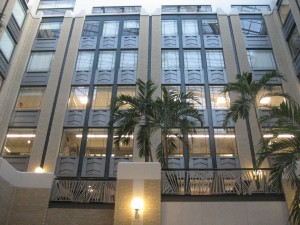The Landmark Center, Park Drive and Brookline Avenue
Tuesday, March 15th, 5:54pm
It’s a beautiful, sunny day in mid-March. I’m soaking up some rays on a bench in the courtyard outside an office building. Rows of protruding metal triangles lend an art deco feel to the building and direct one’s gaze inexorably upward to the bright blue sky above. A plane trails a fine line of exhaust as it jets across the sky from right to left.
Two guys in worn-in jeans and T-shirts are up on eight-foot ladders in the process of blocking out a new sign for the entrance to one of the new offices moving in to the building. On both the ground level and the second-floor deck, palm trees rise out of planters and fill the courtyard with the feel of summer. After a particularly brutal winter, I am reveling in the fact that the weather is finally warm enough for me to sit outside…
For a moment, the sun, the warmth, and the architecture have transported me to an everyday scene in Miami or LA in the 1920’s or 30’s. But I am in Boston. It’s 2011. I can now see the new sign being spelled out is for a Harvard Medical School research center. And the courtyard I am sitting in is an enclosed atrium within the Landmark Center office tower. My view of the sky is actually filtered by glass panes supported by an eccentric white metal grid.
Originally inhabited by Sears, Roebuck and Company for much of the early to mid-twentieth century, this complex was rescused from decades of abandonment and dilapidation about ten years ago. The old beige brick exterior has been re-finished and accented with broad glass window panes and metal art deco ornamentation. The grandeur of the front desk, the glossy floors, and the rows of new lighting fixtures continue to persuade me I have traveled to a busy urban office tower in some decades-old era.

However, I need only step outside to return back to reality. The complex has become a mixed-use, transit-oriented development where office tower meets shopping mall. The facade of the building fronts onto a particularly harrowing traffic intersection where the Riverway, Park Drive, and Fenway merge together into a confusing roundabout that intersects both Brookline Avenue and Boylston Street. A few links of Frederick Law Olmsted’s Emerald Necklace traipse unhappily through the center of this commotion to connect parks from the Muddy River to the Fens.
Staples, Best Buy, Bed, Bath & Beyond, REI, AMC Loews Theater, Panera Bread, and the other ground-floor chain retail locations are accessible from the Fenway Green Line stop or by braving the aforementioned intersection, parking lots, and indoor garage at the Landmark Center. While these transportation modes theoretically qualify the development as transit-oriented, for pedestrians the journey is rather trying. Only by crossing Dante’s first traffic circle of hell or surviving the cross-parking lot trek from the T can the most talented Froggers even hope to reach the stores. Upon arriving safely on the sidewalk that wraps around the building, these fittest survivors are reminded they are not in Miami by massive wind tunnels that make passage from store to store more intimidating than expected.
The Landmark Center has been a foundational anchor for a revitalized area of the Fenway. The salvation of this historical treasure with such care and creativity was unimaginable as recently as fifteen years ago. Nevertheless, as an avid pedestrian and transit rider, the development leaves me wanting something more. I wish I could go back in time and tell them to tweak a few elements of the redevelopment plan. Or maybe I just wish I lived in Miami.
